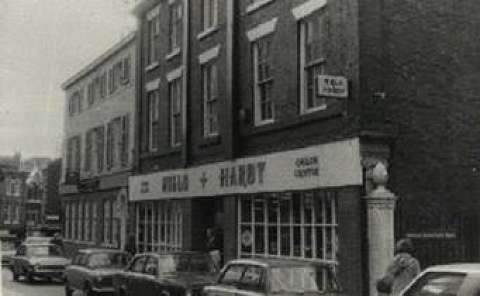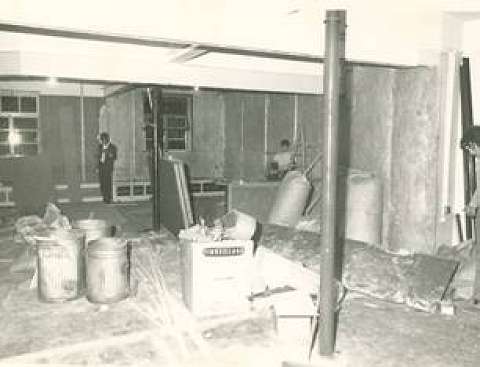
A celebration of Strawberry Recording Studios, Stockport,
1967 - 1993.

An early mention for Strawberry Studio in 1967
Strawberry North: History

Strawberry’s story begins in 1967 with Inter-City Studios located in a tiny twenty-foot-square studio above the Nield and Hardy record store in Stockport’s town centre (above). Having helped out there for a few months, local man Peter Tattersall (who had worked in the music business as a road manger with such groups as Billy J Kramer and the Dakotas) decided to buy the studio and its equipment, which consisted of two tape machines and a few microphones. He paid approximately five hundred pounds and, for the next few months, worked from seven in the morning until two in the afternoon at a local bakery in order to raise money for the studio.
In 1967, there were no other professional recording facilities outside of London and Inter-City settled for offering the studio for the recording of advertisements and demonstration tapes for local artists such as The Mindbenders and Herman's Hermits. It was at this point that Eric Stewart, a member of the Mindbenders, became associated with the Studio. Having always wanted to become involved in that side of the business, Stewart accepted an offer from Tattersall to become a partner and, in spite of being told that it was a waste of time, money and effort, Stewart invested eight hundred pounds in Inter-City and set about improving the standard of the equipment.
His arrival also later brought about a change of name for the studio; Stewart's favourite song at the time was The Beatles' Strawberry Fields Forever so he and Tattersall chose the name Strawberry Recording Studios, with the catchy advertising slogan 'Strawberry Studios Forever' in mind and Strawberry Recording Studios Limited (UK) Limited was incorporated on October 20th 1967.

Within a few months, though, Tattersall and Stewart were told that they were considered to be a fire-risk to the historic building next door and were informed that they would have to vacate the premises. After much searching, they found a building in nearby Waterloo Road that offered a suitable shell for a recording studio and they set about constructing the studio space themselves. Above: Work begins at Waterloo Road (with Eric Stewart, far right)
With additional financial support from other backers (local songwriter Graham Gouldman invested £2,000 and the artist-management firm Kennedy Street Enterprises also became a partner and provided some much-needed respectability for the project), Strawberry upgraded its equipment and began to offer recording facilities for a wide variety of locally-based artists. By 1969, Gouldman was working in New York for the Kasenetz-Katz ‘bubblegum’ music organization and he persuaded them to base their UK operations at Strawberry and to use Stewart and two other friends, Kevin Godley and Lol Creme, as session musicians. The money from these sessions saw the trio producing records to be released under a variety of pseudonyms and, although they felt there was little artistic merit in these tracks, they allowed the studio to purchase of a four-track tape machine and, in 1970, for Stewart, Godley and Creme to record a single together under the name 'Hotlegs' which reached number 2 in the UK charts. Although a Hotlegs album followed, the group (now joined back in Stockport by Graham Gouldman) settled for working in Strawberry as producers and, occasionally, backing musicians for a wide variety of other artists. These included songs by Manchester City, Leeds United, Everton and Bury football clubs and, most notably, fading American star Neil Sedaka, who made a comeback by recording two albums at Strawberry, with Stewart, Gouldman, Godley and Creme as his backing musicians and co-producers. Having worked hard for others to be successful, the four musicians decided to record together for themselves and, with the backing of Jonathan King’s UK Records, they released a single in 1972, Donna, under the name of 10cc, which reached number two in the UK charts.
The period between 1972 and 1976 was one of great success for 10cc and one that, consequently, established Strawberry as a major recording studio. All four 10cc albums (and eight top-ten singles, including two number one records) were recorded in Stockport and, as the band invested their financial gains into Strawberry, it allowed the studio to progress from four to twenty-four track and to bring in the internationally-renowned acoustic designers, Westlake Audio, to design and construct a new control room. As well as being home for 10cc, Strawberry was still available for outside bookings and the Studio was used by such artists as Paul McCartney (who recorded an album at Strawberry with his brother Mike McGear), the Bay City Rollers, Mandalaband and Granada Television, who pre-recorded tracks for those artists appearing on their Lift Off music programme. Indeed, Strawberry became so successful that, by 1975, 10cc were having difficulty in booking time in their own studio and, by the time they had recorded their 1976 album How Dare You in Stockport, they had already taken the decision to build a second Strawberry Studios, this time in Dorking, Surrey, to give themselves the time and space that had been available in the early days in Stockport. Unfortunately, by the time they began to record their first album at Strawberry South, 10cc had split in half, with Godley and Creme leaving the band to pursue a separate career.
In spite of 10cc’s move to Strawberry South, the period from 1976 onwards was still one of success for Strawberry North and, by the end of the decade, they were able to open a second, smaller studio across the road (known as Strawberry 2) in an attempt to offer recording facilities (utilizing some of the Studio’s older equipment) at a reduced rate. As well as the return of artists who had already used the Studio (such as Godley and Creme, Barclay James Harvest, the Syd Lawrence Orchestra and, indeed, 10cc for one last visit in 1982/83), a new generation of bands visited Stockport to record their work. By the late 1970s, producer Martin Hannett was beginning an association with Strawberry that would last until his death in 1991, producing such bands as Joy Division, Durutti Column, Pauline Murray, The Names, Minny Pops, Stockholm Monsters and The Stone Roses, and using the Studio facilities to mix songs by OMD, A Certain Ratio and the Happy Mondays. Other notable names who recorded at Strawberry included The Buzzcocks, New Order, Crispy Ambulance, Blitz, The Wake, James, The Smiths, Simply Red and Saint Winifred’s School Choir.
By 1986, however, the recording studio industry was in a state of flux with the advent of digital recording and the growing number of ‘do-it-yourself’ computerized instruments such as the Synclavier and Fairlight. Strawberry, in spite of its reputation, was finding it difficult to keep up with these changes and in March 1986 it was announced in the local press that the Studio was being purchased by a rival concern, Yellow 2, (who had taken over the Strawberry 2 building only a couple of years previously), with the actual change of directors taking place on March 5th 1986. Yellow 2’s owner, Nick Turnbull, proudly declared at the time, “The Strawberry name is one of the best in the world. We believe the studio’s reputation, coupled with the extraordinary growth of Yellow 2, will put our engineers and producers at the sharp end of the British recording scene.” Initially, this arrangement allowed Strawberry to comprise two studios, one fully digital and still known as Yellow 2, although this set-up was contracted to just the one studio at the original Waterloo Road site in 1988 as “spreading the talent of both producers and engineers between the two studios during the last two years has created the complicated problem for artists as to which studio to use.” The impetus created by the merger gave the Studio an initial spur and, in 1988, the Sunday Express, in its review of Northern recording studios, reported that “Strawberry Studios in Stockport have established an international reputation.” However, with technology moving on at a pace it became difficult for the smaller studios to keep up with those record-company owned studios which had the financial backing to upgrade their equipment where necessary and one employee at this time, John Pennington (who had started as YTS trainee at Strawberry in the mid-1980s), was well placed to observe the Studio’s gradual decline:
The industry kind of withdrew to
London and Strawberry had a financial shortfall. It wasn’t charging
enough, despite the incredible stuff that was being produced there, and
with seven employees it was starting to struggle … I think in a way it
just seemed to lose the lust for the cutting edge. Strawberry got left
behind.
It came as no surprise, therefore, when it was announced in the early 1990s that Strawberry’s owners had decided to concentrate on video production rather than sound recording, thus ending nearly a quarter of a century of such activity in Stockport. Indeed, by 1993, Strawberry had closed its doors altogether, ending its association with the town.
Page updated by Peter Wadsworth, March 2009.